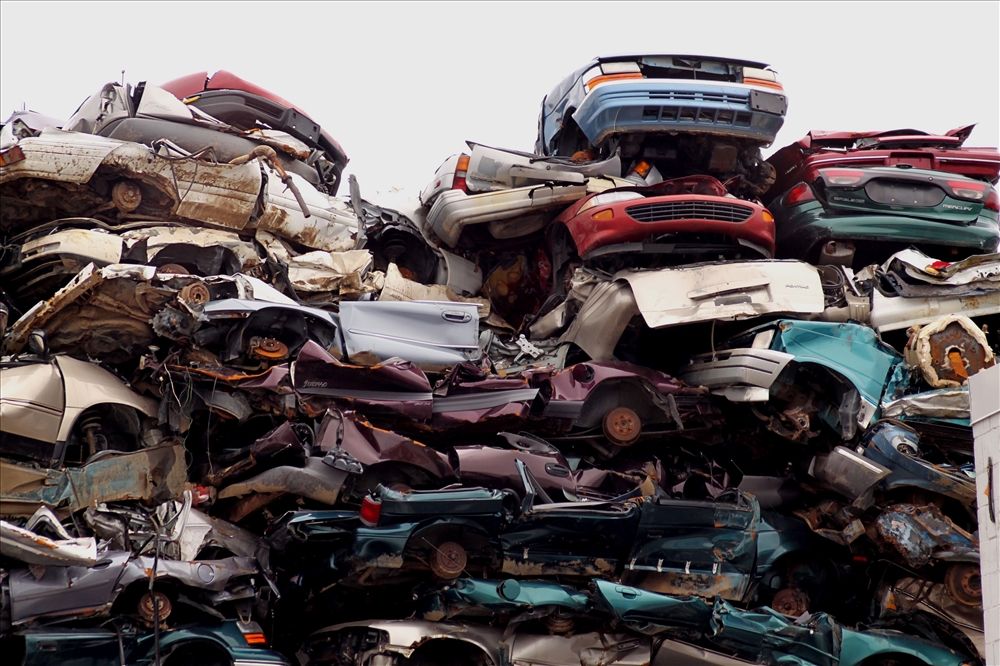
A collection network (with hazardous / MoTAT / ADR and non-hazardous waste vehicles) has been established to ensure the recycling of all automotive-sourced waste and ELVs (including production and service-related waste / scrap, parts changed during repair and out of use parts), recovery (raw material and energy) and/or regular storage/destruction/disposal processes are managed after passing through waste logistics, waste acceptance, storage, decontamination, dismantling, processing, waste sludge drying processes.
(All these processes can be monitored transparently and reliably through the web-based waste management system (AYS))
automotive ELV activity management
Receiving (vehicle barcoding), transportation, issuing the disposal form, decontamination, dismantling (part-based barcoding including brand, model, engine / chassis number) of ELVs in M1, N1 status, storage, processing, recovery, neutralization, destruction / disposal and reporting activities (ELV temporary storage, scrap metal / ELV processing and establishment of ELV collection network including ELV delivery place with provincial compliance certificate in 81 provinces ),
automotive service non-hazardous waste management
Regarding all non-hazardous wastes originating from automotive service; performing waste logistics, waste acceptance / entry, sorting, storage, processing, recovery, landfill and / or disposal processes and reporting,
automotive service hazardous waste management
Regarding all hazardous wastes from service including airbag / seat belt / inflator, waste battery / accumulator (including voltage measurement), catalyst (catalytic converter) / DPF, WEEE (PCB / printed circuit board containing parts) etc, performing waste transportation / logistics, separation, storage, neutralization, processing, recovery and / or destruction / disposal processes with hazardous waste vehicles (MoTAT / ADR) (part-based barcoding / labeling, online tracking) and reporting,
automotive non-use parts management
Collection of unused parts and dead stocks (barcoding / labeling on the basis of parts, online tracking), counting and control, storage, processing, recovery, disposal / destruction processes and reporting,
insurance ELV activity management
Transportation, including the legal procedures and procedures of fully damaged vehicles and damaged vehicles, which are not economically feasible to be repaired within the scope of ELV regulation and communiqué (including M1, N1, truck-bus-electric / hybrid vehicles), issuing the disposal form and classifying as scrap, purification, dismantling, processing, recycling, destruction / disposal activities (including vehicle and all reuse parts barcoding, record creation , cleaning-dismantling-part-based photography) of the same, entering and reporting reusable parts and wastes,
insurance reusable parts management
Fulfilling the procurement and logistics processes of reusable parts that can be used in traffic policy damages,
Storage of ELV and/or damaged vehicles in the damaged vehicle depots of the insurance company holding the status of individual warehouse, which has received a letter of conformity from the provincial directorate,
insurance return parts management
Receiving the parts replaced during the repair in accordance with the insurance policies under the damage repair report prepared by the authorized insurance experts, performing activities related to waste logistics, counting and control, reuse and/or recovery (including disposal) operations, waste entries, reporting ( part-based barcoding, photography, record creation during delivery),
insurance hazardous waste / parts management
Collection of hazardous wastes such as airbag/seat belt / inflator, waste battery / accumulator (including voltage measurement), catalyst (catalytic converter) / DPF, WEEE (PCB / printed circuit board containing parts) etc., performing waste storage, neutralization, processing, recovery and / or destruction / disposal processes with hazardous waste vehicles (MoTAT / ADR) (part-based barcoding / labeling, online tracking) and reporting,
